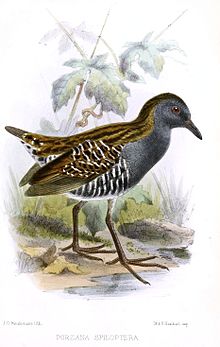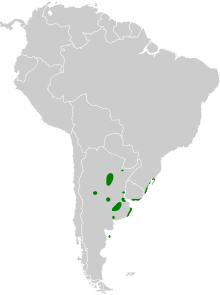|
Dot-winged crake
The dot-winged crake (Laterallus spiloptera) is a vulnerable species of bird in subfamily Rallinae of family Rallidae, the rails, gallinules, and coots.[2][3][1] It is found in Argentina, Brazil, Chile, and Uruguay.[4] Taxonomy and systematicsThe dot-winged crake was originally described in genus Porzana. However, phylogenetic analyses of mitochondrial DNA by Garcia et al. (2014) placed it in the predominantly South American clade Laterallus.[5] Stervander et al. (2019) demonstrated that it is the sister species of the world's smallest flightless bird, the Inaccessible Island rail Laterallus rogersi (previously placed in the monotypic genus Atlantisia) and should bear the binomial Laterallus spilopterus,[6] which was supported by Kirchman et al. (2021).[7] As of late 2022, the International Ornithological Committee (IOC) calls the dot-winged crake Laterallus spiloptera, BirdLife International's Handbook of the Birds of the World calls it Laterallus spilopterus, and the Clements taxonomy and the South American Classification Committee of the American Ornithological Society (SACC) call it Porzana spiloptera.[2][3][8][9] The worldwide taxonomic systems agree that the species is monotypic.[2][3][8] DescriptionThe dot-winged crake is 14 to 15 cm (5.5 to 5.9 in) long. The sexes are alike. Their upperparts are dark olive brown with blackish streaks and some white markings on the flight feathers. Their face and breast are dark gray and their vent area and undertail coverts are barred black and white.[10] Distribution and habitatThe dot-winged crake's distribution is unsettled. The IOC and Clements place it in southern Uruguay and northern Argentina.[2][8] The Cornell Lab of Ornithology's Birds of the World adds Brazil's southernmost state, Rio Grande do Sul, and the SACC adds Chile to those three countries.[10][4] Cornell's eBird has records in all four countries.[11] The dot-winged crake inhabits freshwater and brackish waters and some drier landscapes as well. It is found in freshwater and tidal marshes, swamps, wet meadows, grasslands, and riparian scrub.[10] BehaviorMovementNo movements are known for the dot-winged crake.[10] FeedingThe dot-winged crake feeds on insects, seeds, and marsh vegetation. Its foraging technique has not been documented.[10] BreedingA dot-winged crake nest was discovered near Buenos Aires but no details of it or any other aspects of the species' breeding biology are known.[10] VocalizationThe dot-winged crake's song is " a high note followed by a lower-pitched rattle 'kee-krrrrr'" that is repeated several times. Its calls include "a mellow soft 'pwup' and a scolding rattle."[10] StatusThe IUCN originally assessed the dot-winged crake as Threatened and since 1994 as Vulnerable. Its range is small and fragmented, and its estimated population of 2500 to 10,000 mature individuals is believed to be decreasing. Conversion of wetlands to agriculture, especially grazing with accompanying burning, appears to be the main threat. Other wetlands have been flooded.[1] It occurs in a few protected areas but "[d]istributional surveys [are] urgently needed within [the] species' limited range".[10] References
|
||||||||||||||||||||||||||||||||||||
Portal di Ensiklopedia Dunia


